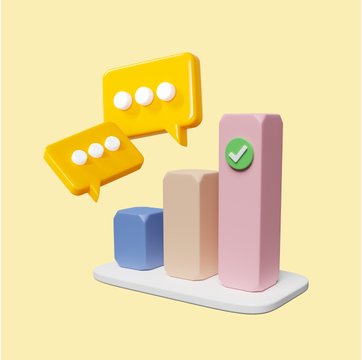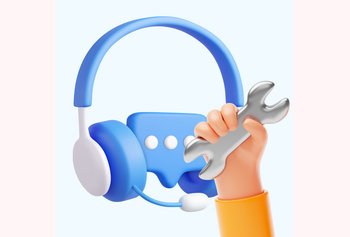21 Live Chat Statistics Every Business Should Know in 2025

Table of contents
If you’ve considered adding live chat support to your customer service arsenal, you’re likely aware of its potential benefits. But recognizing its value and convincing your manager to make the investment are two different things. How do you present a compelling case that goes beyond anecdotal evidence and personal conviction?
In this blog, we’re not just throwing around opinions; we’re bringing you hard-hitting statistics that can serve as your arsenal when making the case for live chat support.
From revealing customer preferences to showcasing operational efficiencies, these statistics are more than just numbers—they’re compelling arguments for why live chat is a must-have in today’s customer service toolkit.
Table of Contents
- Live Chat Statistics on Customer Preferences and Satisfaction
- Live Chat Statistics on User Behavior and Customer Loyalty
- Live Chat Statistics on Operational Efficiency
- Live Chat Statistics on Wait Times and Queue Management
- Live Chat Statistics on Industry Trends and Seasonal Patterns
- Optimize your support operations with Live Chat
Live Chat Statistics on Customer Preferences and Satisfaction
Gone are the days when customers would patiently wait on hold, listening to elevator music. Today, they want answers, and they want them now. Live chat offers that instant gratification. Understanding how users behave and engage with your platform is crucial for any business.
Imagine you run an online clothing store. A customer is unsure about sizing and wants immediate clarification. Instead of sending an email and waiting for a reply, they can simply initiate a live chat and get an answer within seconds. This immediate response satisfies the customer and increases the likelihood of them making a purchase.
These live chat statistics help you understand the pivotal role that customer preferences and satisfaction have in shaping effective customer service.
- 63% of consumers prefer Live Chat as a channel of support communication.
- Live chat leads to a 48% increase in revenue per chat hour and a 40% increase in conversion rate.
- 1 in 5 customers are willing to stop using a product or service for slow response times via online chat.
- 82% of customers were satisfied with their live chat experience, compared to just 61% of email users and a worrying 44% of phone users.
Understanding customer preferences isn’t just good practice; it’s essential for business growth. Live chat is no longer a ‘nice-to-have’; it’s a ‘must-have’ if you want to meet your customers where they are and keep them happy once they get there.
Live Chat Statistics on User Behavior and Customer Loyalty
Let’s say you’re in charge of an online electronics store. A customer is confused about the specifications of two similar laptops. Your live chat agent can quickly clarify the differences, making it easier for the customer to make a decision. This immediate assistance can be the tipping point that converts a browser into a buyer.
From customer loyalty to sales conversions, these live chat statistics will provide actionable insights for your support strategy.
- 60% of customers are more likely to return to a website that offers live chat.
- 63% are more likely to purchase from websites with live chat widgets.
- 38% of people will likely complete their first purchase on websites offering live chat support.
- Around 73% of clients (between ages 18 and 49) say live chat is the most convenient way to communicate with a business.
User behavior and engagement metrics are not just KPIs; they’re the pulse of your business. Live chat, including tools like a live chat widget, can significantly influence these metrics, turning potential customers into loyal brand advocates. As you prepare to make your case for live chat, consider how these insights can serve as compelling arguments for its implementation.
Live Chat Statistics on Operational Efficiency
When it comes to customer service, efficiency is the name of the game. But how do you balance speed with quality?
One of the key benefits of live chat is the ability to handle multiple conversations simultaneously, something that’s not feasible with phone support.
Imagine you manage an e-commerce website that sells kitchen appliances. Questions about shipping and returns are common. Your agents can use predefined responses for these FAQs, freeing them up to handle more complicated issues like technical specifications or bulk orders.
Before we explore the live chat statistics, let’s pause to consider how operational efficiency serves as the backbone of any successful customer service strategy.
- Customer satisfaction rate is at the highest (84.7%) when the first response time is 5 to 10 seconds.
- 53% of businesses that use chat technology are able to resolve problems in just one interaction.
- Customers prefer live chat because it allows them to be more efficient as well. 79% say that they choose it over other channels because they can get their questions answered faster. Meanwhile, 51% say they like it because they can multitask.
- Nearly 69% of organizations use canned messages in their chat responses.
- The average response time for emails is 12 hours. For social media, it’s 10 hours. But with live chat, customers get answers to their questions in 2 minutes.
Operational efficiency isn’t just about cutting costs but optimizing resources to provide better customer service. As you prepare your case for implementing live chat, these live chat statistics can serve as strong arguments for how live chat can make your operations more efficient and effective.
Live Chat Statistics on Wait Times and Queue Management
No one likes to wait, and long queues can be a deal-breaker for many customers.
One of the standout features of live chat is the ability to initiate conversations almost instantly, reducing customer wait times.
Imagine you’re overseeing a tech support team for a software-as-a-service (SaaS) company. By monitoring live chat queues, you can dynamically assign more agents during high-traffic periods, ensuring that customers aren’t left waiting for extended periods.
These live chat statistics relay how effective management of wait times and queues can significantly impact the customer experience.
- Live chat sessions are initiated within 10 seconds if there’s no queue.
- Average live chat queue length is 5 minutes and 57 seconds. (LiveAgent)
- 28.1% of all customers abandon chat queues. (LiveAgent)
- Average wait time for an agent to begin the chat increased from 37 to 48 seconds in 2018.
- Organizations that scored 90% or higher for customer satisfaction had an average wait time of 46 seconds. (Forbes)
Managing wait times and queues effectively is crucial for customer satisfaction. As you prepare to make your case for live chat, consider these practical examples as evidence of how live chat can significantly improve your ability to manage customer expectations and enhance their overall experience.
Recommended Read:
Top 10 Live Chat Software To Watch Out for in 2025
Live Chat Statistics on Industry Trends and Seasonal Patterns
Understanding the broader landscape of live chat can give you a competitive edge. Knowing when and how to deploy resources can make all the difference.
Let’s say you oversee customer support for an online retailer. Knowing that live chat volumes spike during the holiday season, you can plan ahead by training temporary staff or implementing chatbots to handle the increased load.
These live chat statistics acknowledge the importance of staying attuned to industry trends and seasonal patterns, as they offer valuable context for any live chat strategy.
- Live chat is expected to grow by as much as 87% in the next 12-18 months.
- Average chat volume per month dips in the summer and increases significantly in October, November, and especially December. (Forbes)
- Chatbots handled nearly 27% of total chats from start to finish without the need for an agent. (Forbes)
Being aware of industry trends and seasonal patterns isn’t just good for trivia; it’s essential for strategic planning. As you build your case for live chat, these insights can serve as compelling arguments for timely and industry-specific implementation.
Recommended Read:
Live Chat Best Practices | The Ultimate List of Dos and Don’ts
Optimize your support operations with Live Chat
As we’ve navigated through the various facets of live chat, from customer preferences to operational efficiencies, one thing is abundantly clear: live chat is not just a supplementary channel for customer support; it’s becoming a necessity.
The live chat statistics we’ve explored offer more than just numbers; they provide actionable insights that can significantly impact your customer service strategy.
Whether you’re a manager looking to make a case for live chat support or a customer service professional aiming to optimize your existing setup, the data speaks for itself.
Consider these statistics as your roadmap. They can guide your decisions, shape your strategies, and, most importantly, help you deliver a customer experience that’s not just satisfactory but exceptional.

































